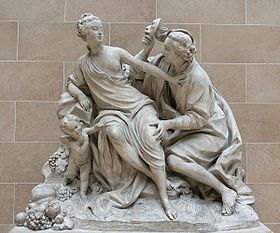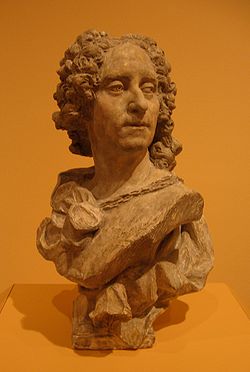
Jean-Baptiste Lemoyne
Encyclopedia

France
The French Republic , The French Republic , The French Republic , (commonly known as France , is a unitary semi-presidential republic in Western Europe with several overseas territories and islands located on other continents and in the Indian, Pacific, and Atlantic oceans. Metropolitan France...
sculptor
Sculpture
Sculpture is three-dimensional artwork created by shaping or combining hard materials—typically stone such as marble—or metal, glass, or wood. Softer materials can also be used, such as clay, textiles, plastics, polymers and softer metals...
, among the greatest French portraitists. He was the pupil of his father, Jean-Louis Lemoyne
Jean-Louis Lemoyne
Jean-Louis Lemoyne was a French sculptor whose works were commissioned by Louis XIV and Louis XV.His sculptures are featured in major art museums, including the Louvre, the Metropolitan Museum of Art, the Frick Collection, the Museum of Fine Arts, and the National Gallery of Art...
, and of Robert Le Lorrain
Robert Le Lorrain
Robert Le Lorrain was a French baroque sculptor who was born in Paris. He was born into a family of bureaucrats, the son of Claude Le Lorrain, a business agent of Nicolas Fouquet, Louis XIV's Minister of Finance. Le Lorrain was a student of the French sculptor, painter, and architect, Pierre...
.
He received the prix de Rome
Prix de Rome
The Prix de Rome was a scholarship for arts students, principally of painting, sculpture, and architecture. It was created, initially for painters and sculptors, in 1663 in France during the reign of Louis XIV. It was an annual bursary for promising artists having proved their talents by...
awarded by the Académie royale de peinture et de sculpture, but remained in Paris to aid his blind father. he was a great figure in his day, around whose modest and kindly personality there waged opposing storms of denunciation and applause, as the Rococo
Rococo
Rococo , also referred to as "Late Baroque", is an 18th-century style which developed as Baroque artists gave up their symmetry and became increasingly ornate, florid, and playful...
style he embodied was rejected in favor of Neoclassicism
Neoclassicism
Neoclassicism is the name given to Western movements in the decorative and visual arts, literature, theatre, music, and architecture that draw inspiration from the "classical" art and culture of Ancient Greece or Ancient Rome...
; Charles Othon Frédéric Jean-Baptiste de Clarac
Charles Othon Frédéric Jean-Baptiste de Clarac
Charles Othon Frédéric Jean-Baptiste, Comte de Clarac was a French artist, scholar and archaeologist.-Life:Emigrating on the Revolution, he travelled round Europe, finding success in drawing and archaeology. He became tutor to the children of Joachim Murat, king of Naples, and was charged by...
asserted that he had delivered a mortal blow at sculpture. His freedom of composition was read as disregard of the classic tradition and of the essentials of dignified sculpture and he was accused of lack of firmness and of intellectual grasp of the larger principles of his art.
Lemoyne's more important works have for the most part been destroyed or have disappeared. The equestrian statue of Louis XV
Louis XV of France
Louis XV was a Bourbon monarch who ruled as King of France and of Navarre from 1 September 1715 until his death. He succeeded his great-grandfather at the age of five, his first cousin Philippe II, Duke of Orléans, served as Regent of the kingdom until Louis's majority in 1723...
for the military school, and the composition of Pierre Mignard
Pierre Mignard
Pierre Mignard , called "Le Romain" to distinguish him from his brother Nicolas Mignard, was a French painter...
's daughter, Mme Feuquières, kneeling before her father's bust (which bust was by Coysevox
Antoine Coysevox
Charles Antoine Coysevox , French sculptor, was born at Lyon, and belonged to a family which had emigrated from Spain...
) were destroyed in the French Revolution
French Revolution
The French Revolution , sometimes distinguished as the 'Great French Revolution' , was a period of radical social and political upheaval in France and Europe. The absolute monarchy that had ruled France for centuries collapsed in three years...
. The bas-relief panels only have been preserved.
In his portrait busts evidence of his riotous and florid imagination to a great extent disappears, and we have a remarkable series of important portraits, of which those of women are perhaps the best. Among Lemoyne's leading achievements in this class are Fontenelle
Bernard le Bovier de Fontenelle
Bernard Le Bovier de Fontenelle , also called Bernard Le Bouyer de Fontenelle, was a French author.Fontenelle was born in Rouen, France and died in Paris just one month before his 100th birthday. His mother was the sister of great French dramatists Pierre and Thomas Corneille...
(at Versailles), Voltaire
Voltaire
François-Marie Arouet , better known by the pen name Voltaire , was a French Enlightenment writer, historian and philosopher famous for his wit and for his advocacy of civil liberties, including freedom of religion, free trade and separation of church and state...
, Latour (all of 1748), the duc de la Vrillière (Versailles), comte de Saint-Florentin, and Crébillon
Prosper Jolyot de Crébillon
Prosper Jolyot de Crébillon was a French poet and tragedian.-Life and works:He was born in Dijon, where his father, Melchior Jolyot, was notary-royal. Having been educated at the Jesuit school in the town, and afterwards at the Collège Mazarin. He became an advocate, and was placed in the office...
(Dijon Museum); the actresses Mlle Chiron and Mlle Dangeville (illustration, left), both produced in 1761 and both at the Théâtre Français in Paris, and Madame de Pompadour
Madame de Pompadour
Jeanne Antoinette Poisson, Marquise de Pompadour, also known as Madame de Pompadour was a member of the French court, and was the official chief mistress of Louis XV from 1745 to her death.-Biography:...
, the work of the same year. Of Pompadour he also executed a statue in the costume of a nymph
Nymph
A nymph in Greek mythology is a female minor nature deity typically associated with a particular location or landform. Different from gods, nymphs are generally regarded as divine spirits who animate nature, and are usually depicted as beautiful, young nubile maidens who love to dance and sing;...
, very delicate and playful in its air of grace. Lemoyne was perhaps most successful in his training of pupils, among them Étienne Maurice Falconet
Étienne Maurice Falconet
Étienne Maurice Falconet is counted among the first rank of French Rococo sculptors, whose patron was Mme de Pompadour.-Life:Falconet was born to a poor family in Paris...
Pigalle, Caffiéri, and Augustin Pajou
Augustin Pajou
Augustin Pajou was a French sculptor, born in Paris. At eighteen he won the Prix de Rome, and at thirty exhibited his Pluton tenant Cerbère enchaîné .-Selected works:...
.


